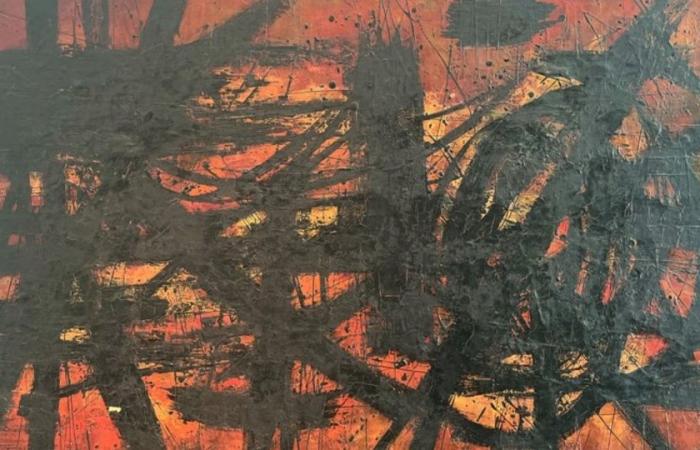
What remained immutable were two things: painting and Japan. Yes, Japan; That very small island nation on the other side of the world that survived two nuclear bombs. Life is very complicated and to advance (survive) something has to stay still. In the biography of Kazuya Sakai – artist, graphic designer, radio broadcaster, translator and Argentine editor – the things that did not move were just those two: the painting and their devotion for the culture of that country. In a very skilled way, he managed to draw connections between the Japanese worldview and Latin America. He designed books and publications to spread the Japanese culture and even participated in the edition that the magazine Onthat publication founded by Victoria Ocampo, dedicated exclusively to the modern literature of that distant place. With patience and conviction, whistling short and without disturbing, Sakai introduced throughout the continent the brands of the eastern rests that he carried.
Kazuya Sakai was born in Buenos Aires on October 1, 1927. when he was just seven years old, his parents sent him to Japan to study. He lived there until the university was finished – he received a degree in Philosophy and Letters – and in 1951 he returned to Argentina. Five years later, at the end of 1956, the Argentine-Japonés Institute was created in Buenos Aires with the aim of spreading the culture and science of that territory. Sakai was part of that institution: he edited several publications, made translations and designs, but his main work was to direct the magazine The cellalthough it only published just three numbers. In parallel, he developed a career within the world of visual arts, mainly as an abstract painter.
Some flashes of its production are gathered in the exhibition Asian minutes: Sakai Translatorinaugurated in Pu Chi Pu Li, a new space of the City of Buenos Aires dedicated to the crosses of the art of southeast with Latin America (the name refers to the Chinese saying whose meaning is “not too familiar not too distant”). In the sample, oils are collected that Sakai made in the late 1950s and inks of the early ’60 – influenced by Japanese calligraphy and informalism – and a set of watercolors and more inks of the ’90s, which show their fascination with the Japanese landscape. In addition, file material is included that accounts for its work as a translator and editor of numerous publications that record the importance of the diffuser of Japanese culture in Argentina. For 25 years, Kazuya Sakai’s collection is under the care of the Vasari gallery.
His pictorial work and the role he had as a cultural agent is impossible to split. Sakai inhabited his work as his biography inhabited: a permanent conversation between Japan and a forgotten continent located on the other side of the planet.
The road to the mountain
The first time he made a sample in Argentina was in 1958. He had arrived from Japan seven years ago, but only then managed to show some works in the Bonino gallery. As of 1951, he worked in a dozen abstract paintings; Somehow, he joined a certain excitement for the abstraction that had begun a few years before, in 1944, with the emergence of concrete art and the appearance of artists such as Tomás Maldonado and Lidy Prati – to whom he recognized as referents -, among others.
The oils gathered on this occasion, corresponding to that period of late ’50s, keep clear references with Japanese calligraphy. Brush the eyes is enough to distinguish some characters from that alphabet. In this sense, Sakai distanced himself from the abstract painters who served as a reference: there is an anchor to something “real” in his works. Perhaps, perhaps unintentionally, he was closer to a cubist, of an artist who deforms the real world a bit without breaking it completely, than a specific artist. Perhaps his commitment to the Japanese tradition was too great at that time to break and tear those lyrics.
However, the change of decade brought some changes in his work. The works of this moment that are exhibited in Asian act They already distance it from any possible figuration. The two watercolors included show a completely abstract artist: in one, two triangles with points that float in air; in the other, circles and vertical and horizontal rectangles. The sixties meant for Sakai’s work a detachment with the figurative rests that he had when he quote Japanese calligraphy.
And if Sakai inhabited his work as his biography inhabited, his arrival in Mexico City also marked some modifications in his work. In 1966 he arrived at the then Federal District. There he was editor in chief and artistic director of Pluralthe magazine directed by Octavio Paz. during that period, Sakai developed his most geometric work and embraced the abstraction of music, that invisible thing that floats in the air and enters the ears. In that context, it opened PInteras: oChromatic and simultaneous ndulationsan exhibition that gathered a series of paintings that carried the name of a sound composition and its author (in parallel, had a radio program specialized in jazz). With these works, finally, Sakai was close to his original referents – Maldonado, Prati – since his paintings were formed by geometric abstractions represented by full colors: curved lines embodied on violet, red and blue funds (these works are currently on display in the Museum of Modern Art of Mexico City).
However, towards the end of his life he had an approach to figuration to portray Japanese geography. In the exhibition, there are two works that he carried out in the ’90s and that refer directly to their fascination with the Japanese landscape: in the watercolors the Mount Fuji and the mountains of Nagano appear. Somehow, after years of displacements – in geographical and visual terms – Sakai returned to the starting point. His work is one hundred percent circular: that land that was a great openness when he was seven years old, from which he could separate fleetingly during his stay in Mexico, was to the same one that returned to the end of his career. Sakai did not know how to betray the origin, to tradition.
You live and translate
Corinna Gepner writes, the essayist and prmiada French translator, in her book Translate or lose foot: “I am not alone when I translate. I translate another, to others, I translate for others. I also translate, want it or not, my time, its distant or immediate history, a certain state of the language, a reading horizon. And with it, I enroll in my world, in my time. I cannot conceive the translation as an activity outside of space and time, stripped of all social function.” While this text was published several decades after Sakai made endless translations from Japanese to Spanish, somehow reflects the spirit that had its feat.
The value of this Sakai sample is just highlighting its work as a diffuser of Japanese culture in Argentina and other countries. The translations of this artist generated a conversation between the Asian diaspora and the Latin American cultural field, perhaps an exchange that was only perceived by a few, but can now be reviewed. In each translation something is won and something is lost: on the one hand, endless people access an unknown universe; on the other, some meaning or the original intention is lost. Faced with this dilemma, Sakai opted for the first option: to ensure that other people could know what fascinated him, without importing the loss that could occur. While working at the Argentine-Japonés Institute, he made translations of authors such as Masaru Katsumie and also made other translations for the magazine Plural in Mexico and for the Eastern Studies Center of that same city.
His early work is the work of a translator, his paintings reflect that passage from one language and another. The images that return the oils just show what is gained and lost in that passage from one language to another, from the word to the image, from calligraphy to abstraction.
Per Beyond the benefits and damages, the value of Sakai’s work as a translator and diffuser of the Japanese culture that indicated the essayist and translator of Latin American literature Edith Groesman: “The translation allows us to savor the transformation of the foreigner into the family and during a brief period to live outside our own skin, of our own preconcepts and erroneous ideas. The translation expands and deepens our world, our world is awareness, countless and indescribable ways. ” The transcendence of this artist, within the field of Argentine art, should then be measured from the following question: how capable Kazuya Sakai was with his translations of recreating the characteristics, oddities and peculiarities of that other language and culture through his paintings and his texts? Reviewing the work of this artist serves to discover that the worldview of a distant island is not too familiar, but not too distant.
Asian minutes: Sakai Translator You can visit in Pu Chi Pu Li (Esmeralda 857) Thursday and Friday from 15 to 19, or by appointment. Free.





